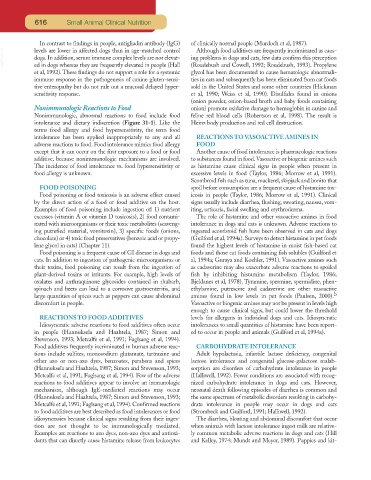Page 594 - Small Animal Clinical Nutrition 5th Edition
P. 594
616 Small Animal Clinical Nutrition
In contrast to findings in people, antigliadin antibody (IgG) of clinically normal people (Murdoch et al, 1987).
Although food additives are frequently incriminated as caus-
levels are lower in affected dogs than in age-matched control
VetBooks.ir dogs. In addition, serum immune complex levels are not elevat- ing problems in dogs and cats, few data confirm this perception
ed in dogs whereas they are frequently elevated in people (Hall
(Roudebush and Cowell, 1992; Roudebush, 1993). Propylene
et al, 1992).These findings do not support a role for a systemic glycol has been documented to cause hematologic abnormali-
immune response in the pathogenesis of canine gluten-sensi- ties in cats and subsequently has been eliminated from cat foods
tive enteropathy but do not rule out a mucosal delayed hyper- sold in the United States and some other countries (Hickman
sensitivity response. et al, 1990; Weiss et al, 1990). Disulfides found in onions
(onion powder, onion-based broth and baby foods containing
Nonimmunologic Reactions to Food onion) promote oxidative damage to hemoglobin in canine and
Nonimmunologic, abnormal reactions to food include food feline red blood cells (Robertson et al, 1998). The result is
intolerance and dietary indiscretion (Figure 31-1). Like the Heinz body production and red cell destruction.
terms food allergy and food hypersensitivity, the term food
intolerance has been applied inappropriately to any and all REACTIONS TO VASOACTIVE AMINES IN
adverse reactions to food. Food intolerance mimics food allergy FOOD
except that it can occur on the first exposure to a food or food Another cause of food intolerance is pharmacologic reactions
additive, because nonimmunologic mechanisms are involved. to substances found in food.Vasoactive or biogenic amines such
The incidence of food intolerance vs. food hypersensitivity or as histamine cause clinical signs in people when present in
food allergy is unknown. excessive levels in food (Taylor, 1986; Morrow et al, 1991).
Scombroid fish such as tuna, mackerel, skipjack and bonito that
FOOD POISONING spoil before consumption are a frequent cause of histamine tox-
Food poisoning or food toxicosis is an adverse effect caused icosis in people (Taylor, 1986; Morrow et al, 1991). Clinical
by the direct action of a food or food additive on the host. signs usually include diarrhea, flushing, sweating, nausea, vom-
Examples of food poisoning include ingestion of: 1) nutrient iting, urticaria, facial swelling and erythroderma.
excesses (vitamin A or vitamin D toxicosis), 2) food contami- The role of histamine and other vasoactive amines in food
nated with microorganisms or their toxic metabolites (scaveng- intolerance in dogs and cats is unknown. Adverse reactions to
ing putrefied material, vomitoxin), 3) specific foods (onions, ingested scombroid fish have been observed in cats and dogs
chocolate) or 4) toxic food preservatives (benzoic acid or propy- (Guilford et al, 1994a). Surveys to detect histamine in pet foods
lene glycol in cats) (Chapter 11). found the highest levels of histamine in moist fish-based cat
Food poisoning is a frequent cause of GI disease in dogs and foods and those cat foods containing fish solubles (Guilford et
cats. In addition to ingestion of pathogenic microorganisms or al, 1994a; Guraya and Koehler, 1991). Vasoactive amines such
their toxins, food poisoning can result from the ingestion of as cadaverine may also exacerbate adverse reactions to spoiled
plant-derived toxins or irritants. For example, high levels of fish by inhibiting histamine metabolism (Taylor, 1986;
oxalates and anthraquinone glycosides contained in rhubarb, Bjeldanes et al, 1978). Tyramine, spermine, spermidine, phen-
spinach and beets can lead to a corrosive gastroenteritis, and ethylamine, putrescine and cadaverine are other vasoactive
large quantities of spices such as peppers can cause abdominal amines found in low levels in pet foods (Paulsen, 2000). b
discomfort in people. Vasoactive or biogenic amines may not be present in levels high
enough to cause clinical signs, but could lower the threshold
REACTIONS TO FOOD ADDITIVES levels for allergens in individual dogs and cats. Idiosyncratic
Idiosyncratic adverse reactions to food additives often occur intolerances to small quantities of histamine have been report-
in people (Hannuksela and Haahtela, 1987; Simon and ed to occur in people and animals (Guilford et al, 1994a).
Stevenson, 1993; Metcalfe et al, 1991; Fuglsang et al, 1994).
Food additives frequently incriminated in human adverse reac- CARBOHYDRATE INTOLERANCE
tions include sulfites, monosodium glutamate, tartrazine and Adult hypolactasia, infantile lactase deficiency, congenital
other azo or non-azo dyes, benzoates, parabens and spices lactose intolerance and congenital glucose-galactose malab-
(Hannuksela and Haahtela, 1987; Simon and Stevenson, 1993; sorption are disorders of carbohydrate intolerance in people
Metcalfe et al, 1991; Fuglsang et al, 1994). Few of the adverse (Halliwell, 1992). Fewer conditions are associated with recog-
reactions to food additives appear to involve an immunologic nized carbohydrate intolerance in dogs and cats. However,
mechanism, although IgE-mediated reactions may occur neonatal death following episodes of diarrhea is common and
(Hannuksela and Haahtela, 1987; Simon and Stevenson, 1993; the same spectrum of metabolic disorders resulting in carbohy-
Metcalfe et al, 1991; Fuglsang et al, 1994). Confirmed reactions drate intolerance in people may occur in dogs and cats
to food additives are best described as food intolerances or food (Strombeck and Guilford, 1991; Halliwell, 1992).
idiosyncrasies because clinical signs resulting from their inges- The diarrhea, bloating and abdominal discomfort that occur
tion are not thought to be immunologically mediated. when animals with lactose intolerance ingest milk are relative-
Examples are reactions to azo dyes, non-azo dyes and antioxi- ly common metabolic adverse reactions in dogs and cats (Hill
dants that can directly cause histamine release from leukocytes and Kelley, 1974; Mundt and Meyer, 1989). Puppies and kit-

